Rhineland pattern, 1st edition, 2 different versions.
Of all the
Braun catalogues Band 4 is solely dedicated to the Dondorf company. All the
Dondorf decks are represented there, complete with extensive information about
the deck and in some cases the different versions. The Rhineland pattern was
created as the Dondorf standard factory pattern and first published around 1870.
It was published by Dondorf until 1933.
In 1928 the playing card division of Dondorf was taken over by Flemming &
Wiskott AG from Glogau, but that company kept the Dondorf name for the Dondorf
decks. In 1933 Flemming & Wiskott was incorporated in the VASS, the
Vereinigte Altenburger und Stralsunder Spielkarten-Fabriken AG. The name Dondorf
was kept for a couple of years in a few decks, maybe because of the quality that
the name Dondorf represented, but maybe just because they were
still in stock. The Rhineland pattern was one of them.
I have no idea when this Dondorf standard factory pattern was first called Rhineland (in
German: "Rheinisches Bild"), but apparently it was a successful
pattern. And when a certain pattern becomes popular, then other playing card
manufacturers will copy it. In this case not only German makers, but it
transgressed borders and was also produced by makers like Piatnik (in Austria,
Hungary and Czechoslovakia) and Belgian makers from Turnhout, such as Van
Genechten and Mesmaekers. It was a popular pattern in the Nordic countries and
in The Netherlands from the 1920's - 60's.
In his Dondorf
catalogue Franz Braun distinguishes 4 variations.
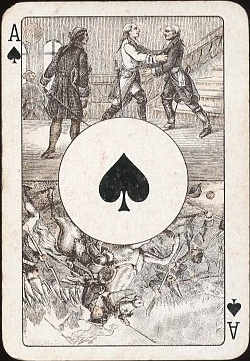 |
These are based on the accompanying aces
or the (rare) special design of the clubs suit as swastika's (var. 4). Variation 1 has plain aces,
variation 2 historic aces and variation 3 has Dutch scenic aces. Within Variation 1 Braun
distinguishes 6 different versions (A-F), based
on the back designs, and he gives different periods of publication, based on the
number and size of the used indices. So there's no distinction made in the way
the face cards are designed. Maybe that's because basically the design of the
pattern didn't really change. However, there's a main difference in the way they
were presented. |
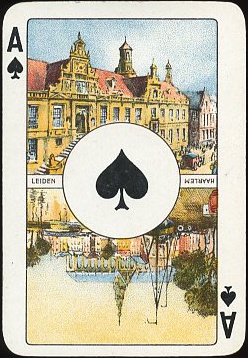
|
|
Variation
2 |
Variation
3 |
|
Braun
shows these 3 versions of Variation 1. |
|
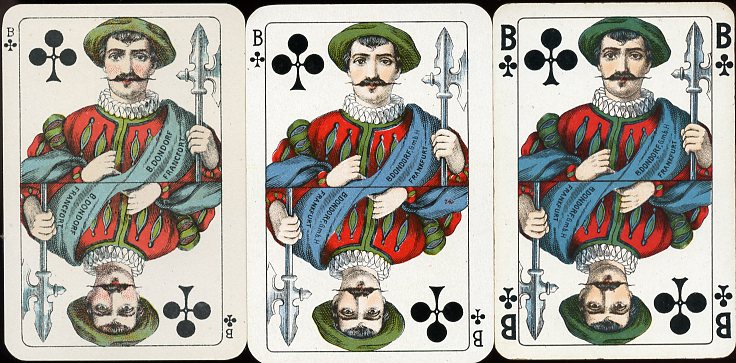
|
| index
2mm: 1890 - 1900 |
index
4mm: 1900 - 1919 |
index
6 mm: 1919 - 1933 |
|
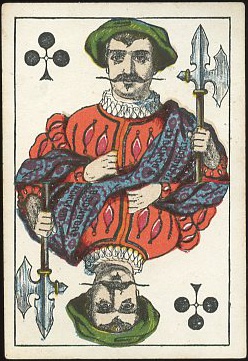 |
Decks without
indices were dated by Braun as ca. 1870 - 1890. So both my decks can be placed
in that period.
But Braun doesn't show the JC of a deck without indices. Instead he shows
the KC, QD, JS and AH. Although the pictured cards in the catalogue are in
b/w it's easy to see that on the QD the yellow fabric lacks the red
embellishments.
Schultz & Stolzenburg show a picture of that QD in color.
So there are at least 2 versions of the version without index. The QD
without embellished garment and round corners probably dates from around
1890.
|
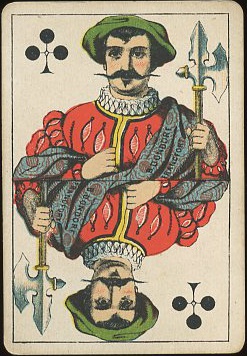 |
Schultz
& Stolzenburg show all the courts of an "embellished" version with rounded corners and a JC with square corners. All cards, the JC included,
are similar to my deck with round
corners. However, there are a few differences between that version and the one
with square corners. Here below are 2 cards from each deck to illustrate them.
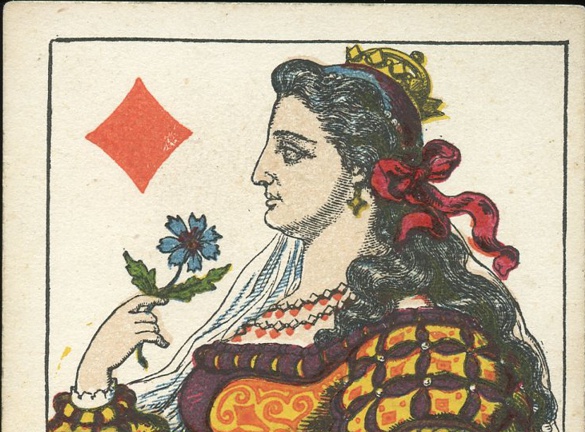 |
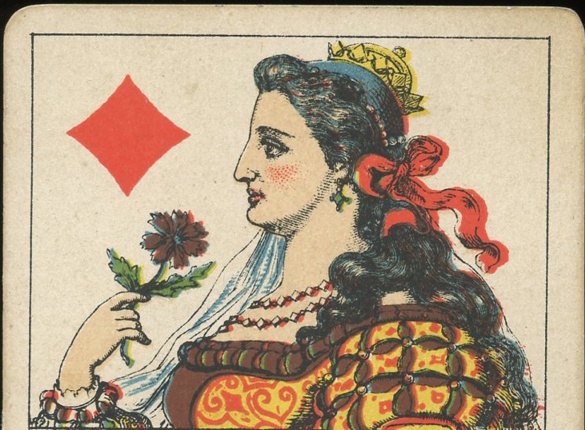
|
|
The
first thing that caught my eye was that the printing wasn't of the high
quality that we would expect from B. Dondorf. Apparently calibrating the
different colors wasn't easy in those days or maybe it wasn't done with
the same attention as for the special or luxury decks. The Rhineland pattern was
created as a standard factory pattern, probably for daily use by players
and sold in the lower price range. Maybe that's also why the coloring of
the square cornered deck looks a bit cruder.
There are a few
differences between these editions, of which the use of a different color
is the least. On the flower a red brown overprint and a completely
different colored sleeve. The most significant difference is the shadowing
at the jaw. In the square cornered, earliest version it's heavier than in
the other version. So either a new drawing on a new stone was made or the
drawing on the original stone was adapted. I tend to believe the latter,
as most of the other lines seem to be the same.
Another difference is the blush on the cheeks. It's used on all the
courts of the version with the round corners. These same blushes are even
more prominent in the deck that is shown by Schultz & Stolzenburg in
their book. |
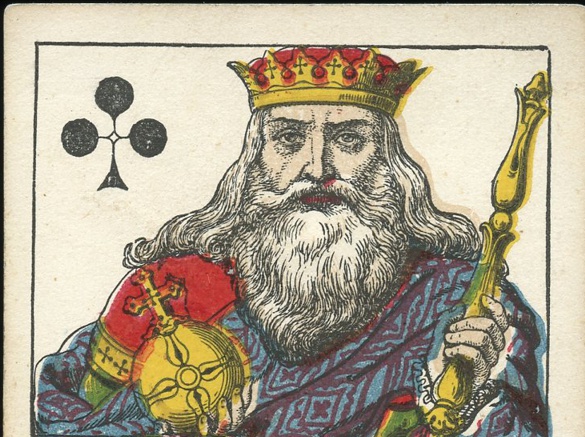 |
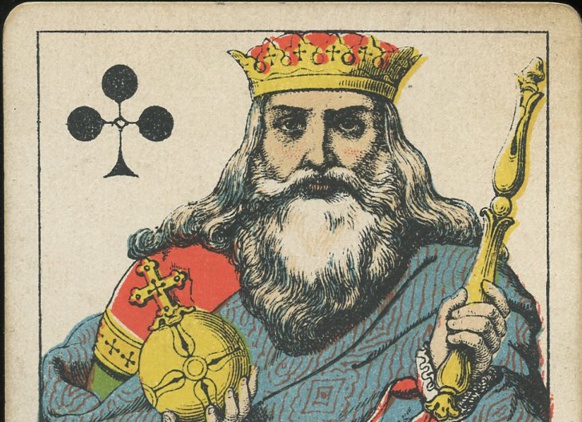 |
|
The
KC basically shows the same flaws and differences. Here the most apparent
differences are the adapted beard and the thick lined and somewhat
different embellishment of the cape. The latter adds to the idea that the
square cornered deck probably is the earliest version and the crude
execution a basis for refinements in later editions. It would date the
square cornered deck as around 1870 and the other as between the later
1870's and late 1880's.
|
|
Both back
designs were used in the oldest versions (Braun: A).
|
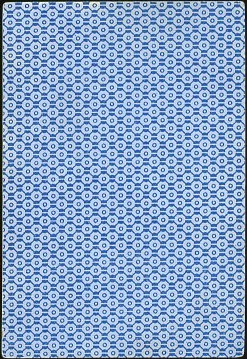 |
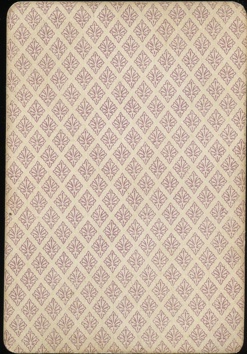
|
|
62x91 mm |
61x90 mm |
In
all his catalogues Franz Braun usually distinguishes variations by differences
in design or execution. Ever since we had found our first
"embellished" deck I have been wondering why Braun didn't mention
this apparent difference, neither in the text nor in the pictured cards. It
isn't mentioned in the later additions to the catalogue that I have, but I'm
not sure if I have all of them. Anyway, we'll never know the answer, as Franz
has sadly passed away some years ago.
So in addition it's good to now know that within the indexless variation there
are at least 3 different versions to distinguish: one without embellished
fabrics and the two here above.
BACK










